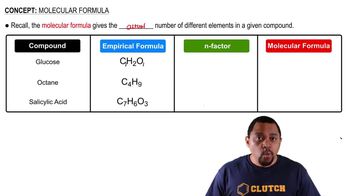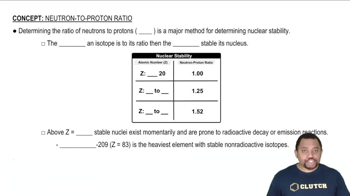Ball-and-stick representations of benzene, a colorless liquid often used in organic chemistry reactions, and acetylene, a gas used as a fuel for high-temperature welding, are shown below. (a) Determine the molecular formula of each.
Ch.2 - Atoms, Molecules, and Ions
Chapter 2, Problem 49a
Write the empirical formula corresponding to each of the following molecular formulas: (a) Al2Br6
 Verified step by step guidance
Verified step by step guidance1
Identify the molecular formula given: \( \text{Al}_2\text{Br}_6 \).
Determine the greatest common divisor (GCD) of the subscripts in the molecular formula. Here, the subscripts are 2 and 6.
Divide each subscript in the molecular formula by the GCD to simplify the ratio. The GCD of 2 and 6 is 2.
Divide the subscript of Al (2) by 2 to get 1, and the subscript of Br (6) by 2 to get 3.
Write the empirical formula using the simplified subscripts: \( \text{AlBr}_3 \).

Verified video answer for a similar problem:
This video solution was recommended by our tutors as helpful for the problem above.
Video duration:
1mWas this helpful?
Key Concepts
Here are the essential concepts you must grasp in order to answer the question correctly.
Empirical Formula
The empirical formula of a compound represents the simplest whole-number ratio of the elements present in that compound. It does not provide information about the actual number of atoms in a molecule but rather the relative proportions of each element. For example, the empirical formula for glucose (C6H12O6) is CH2O, indicating a 1:2:1 ratio of carbon, hydrogen, and oxygen.
Recommended video:
Guided course

Empirical vs Molecular Formula
Molecular Formula
The molecular formula indicates the actual number of atoms of each element in a molecule of a compound. It can be the same as the empirical formula or a multiple of it. For instance, the molecular formula C6H12O6 shows that there are six carbon atoms, twelve hydrogen atoms, and six oxygen atoms in each molecule of glucose, which is a multiple of its empirical formula CH2O.
Recommended video:
Guided course

Determining Molecular Formulas
Reduction of Ratios
To derive the empirical formula from a molecular formula, one must reduce the ratios of the elements to their simplest form. This involves dividing the subscripts in the molecular formula by their greatest common divisor. For example, in Al2Br6, both subscripts can be divided by 2, resulting in the empirical formula AlBr3, which reflects the simplest ratio of aluminum to bromine.
Recommended video:
Guided course

Neutron-Proton Ratio
Related Practice
Textbook Question
1
views
Textbook Question
What are the molecular and empirical formulas for each of the following compounds? Write the molecular formula for the following compound.
Textbook Question
Two substances have the same molecular and empirical formulas. Does this mean that they must be the same compound?
Textbook Question
Write the empirical formula corresponding to each of the following molecular formulas: (b) C8H10
Textbook Question
Write the empirical formula corresponding to each of the following molecular formulas: (c) C4H8O2
Textbook Question
Write the empirical formula corresponding to each of the following molecular formulas: (d) P4O10 (e) C6H4Cl2 (f) B3N3H6.
